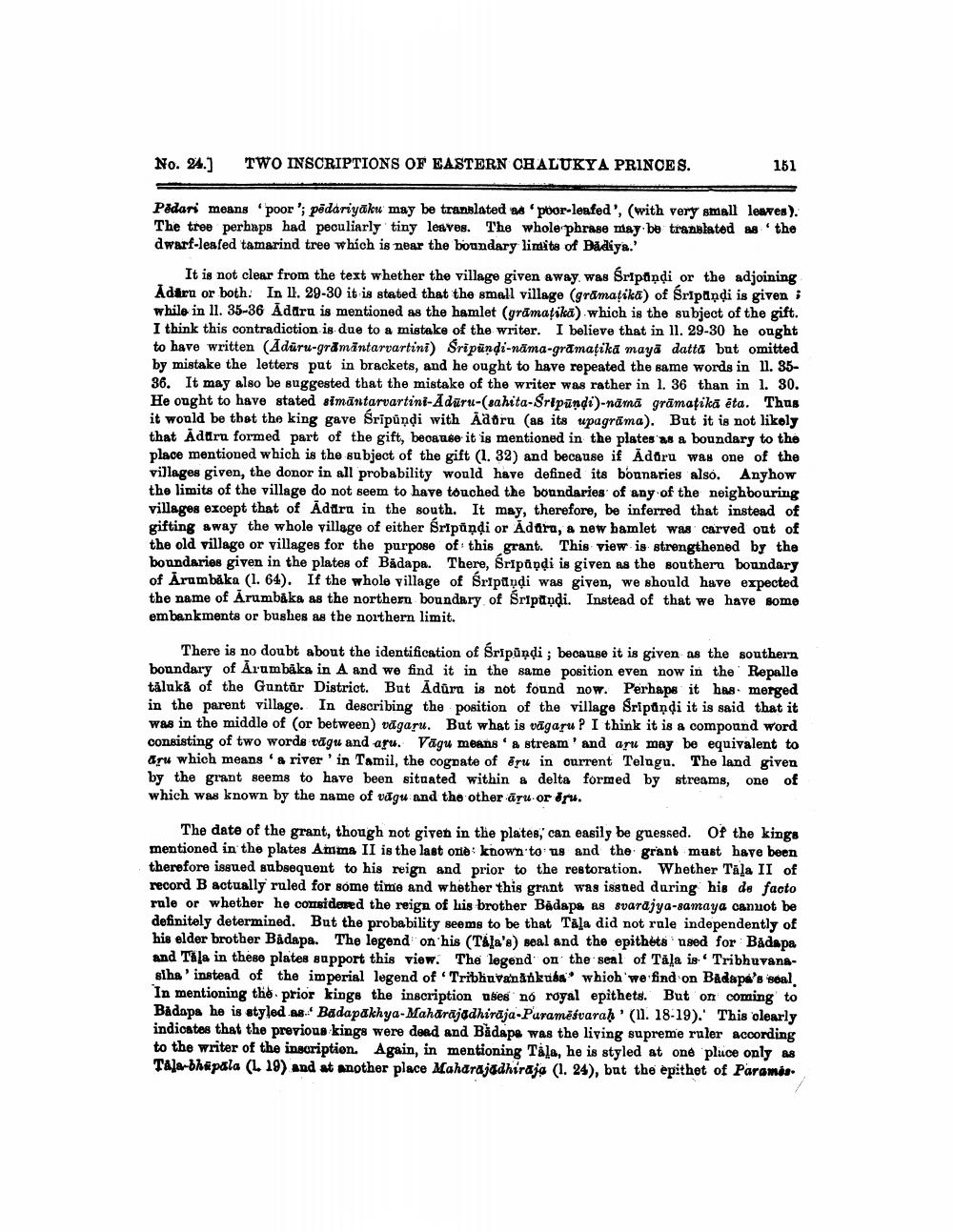________________
No. 24.]
TWO INSCRIPTIONS OF EASTERN CHALUKYA PRINCES.
151
Pēdari means 'poor'; pēdariyāku may be translated as 'poor-leafed', (with very small leaves). The tree perhaps had peculiarly tiny leaves. The whole phrase may be translated as the dwarf-leafed tamarind tree which is near the boundary limits of Badiya.'
4
It is not clear from the text whether the village given away, was Sripandi or the adjoining Adaru or both. In 11. 29-30 it is stated that the small village (gramatika) of Sripandi is given; while in 11. 35-36 Adara is mentioned as the hamlet (gramatika) which is the subject of the gift. I think this contradiction is due to a mistake of the writer. I believe that in 11. 29-30 he ought to have written (Aduru-gramantarvartini) Sripunḍi-nama-grāmaṭikā maya datta but omitted by mistake the letters put in brackets, and he ought to have repeated the same words in 11. 3536. It may also be suggested that the mistake of the writer was rather in 1. 36 than in 1. 30. He ought to have stated simäntarvartini-Aduru-(sahita-Sripundi)-nāmā grāmaṭikā ēta. Thus it would be that the king gave Śripündi with Adoru (as its upagrama). But it is not likely that Aduru formed part of the gift, because it is mentioned in the plates as a boundary to the place mentioned which is the subject of the gift (1. 32) and because if Adaru was one of the villages given, the donor in all probability would have defined its bounaries also. Anyhow the limits of the village do not seem to have touched the boundaries of any of the neighbouring villages except that of Adara in the south. It may, therefore, be inferred that instead of gifting away the whole village of either Śripūṇḍi or Adara, a new hamlet was carved out of the old village or villages for the purpose of this grant. This view is strengthened by the boundaries given in the plates of Badapa. There, Sripandi is given as the southern boundary of Arumbaka (1. 64). If the whole village of Sripundi was given, we should have expected the name of Arumbaka as the northern boundary of Sripundi. Instead of that we have some embankments or bushes as the northern limit.
There is no doubt about the identification of Sripunḍi; because it is given as the southern boundary of Arumbaka in A and we find it in the same position even now in the Repalle täluka of the Guntur District. But Adüra is not found now. Perhaps it has merged in the parent village. In describing the position of the village Sripandi it is said that it was in the middle of (or between) vägaru. But what is vagaru? I think it is a compound word consisting of two words tagu and aru. Vägu means a stream and aru may be equivalent to aru which means a river' in Tamil, the cognate of ēru in current Telugu. The land given by the grant seems to have been situated within a delta formed by streams, one of which was known by the name of vagu and the other aṛu or aru.
The date of the grant, though not given in the plates,' can easily be guessed. Of the kings mentioned in the plates Amma II is the last one: known to us and the grant must have been therefore issued subsequent to his reign and prior to the restoration. Whether Tala II of record B actually ruled for some time and whether this grant was issued during his de facto rule or whether he considered the reign of his brother Badapa as svarajya-samaya cannot be definitely determined. But the probability seems to be that Tala did not rule independently of his elder brother Badapa. The legend on his (Tala's) seal and the epithets used for Bådapa and Tala in these plates support this view. The legend on the seal of Tala is Tribhuvanasiha' instead of the imperial legend of Tribhuvanankusa which we find on Badapa's seal In mentioning the prior kings the inscription uses nó royal epithets. But on coming to Badapa he is styled as Badapakhya-Maharajadhiraja-Paramesvarah' (11. 18-19). This clearly indicates that the previous kings were dead and Badapa was the living supreme ruler according to the writer of the inscription. Again, in mentioning Tala, he is styled at one place only as Tala-bhūpala (119) and at another place Maharajadhiraja (1. 24), but the epithet of Parames




